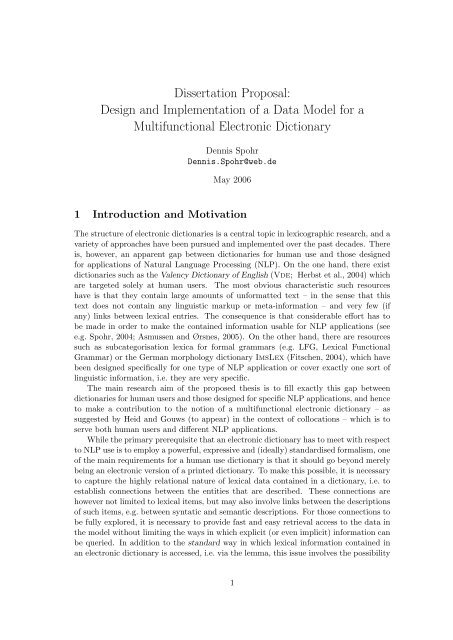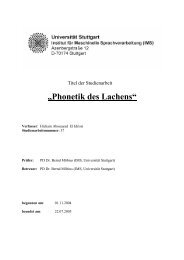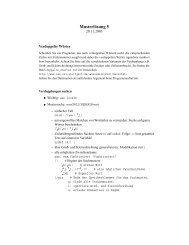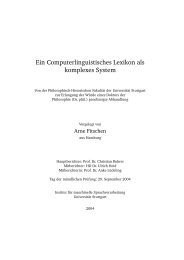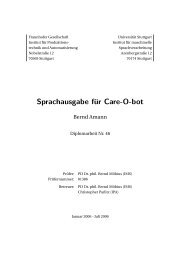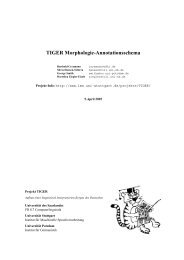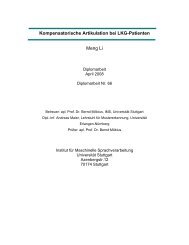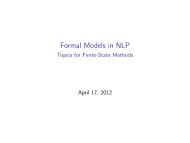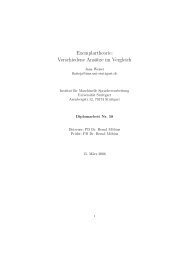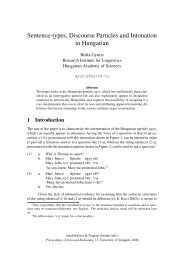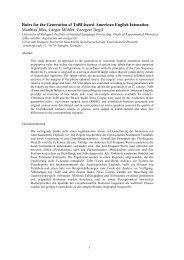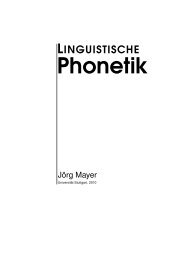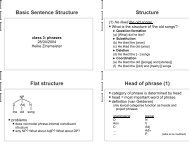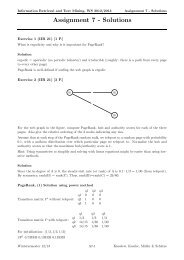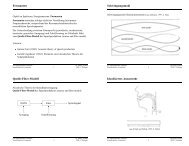Dissertation Proposal: Design and ... - IMS - Universität Stuttgart
Dissertation Proposal: Design and ... - IMS - Universität Stuttgart
Dissertation Proposal: Design and ... - IMS - Universität Stuttgart
Create successful ePaper yourself
Turn your PDF publications into a flip-book with our unique Google optimized e-Paper software.
<strong>Dissertation</strong> <strong>Proposal</strong>:<br />
<strong>Design</strong> <strong>and</strong> Implementation of a Data Model for a<br />
Multifunctional Electronic Dictionary<br />
Dennis Spohr<br />
Dennis.Spohr@web.de<br />
May 2006<br />
1 Introduction <strong>and</strong> Motivation<br />
The structure of electronic dictionaries is a central topic in lexicographic research, <strong>and</strong> a<br />
variety of approaches have been pursued <strong>and</strong> implemented over the past decades. There<br />
is, however, an apparent gap between dictionaries for human use <strong>and</strong> those designed<br />
for applications of Natural Language Processing (NLP). On the one h<strong>and</strong>, there exist<br />
dictionaries such as the Valency Dictionary of English (Vde; Herbst et al., 2004) which<br />
are targeted solely at human users. The most obvious characteristic such resources<br />
have is that they contain large amounts of unformatted text – in the sense that this<br />
text does not contain any linguistic markup or meta-information – <strong>and</strong> very few (if<br />
any) links between lexical entries. The consequence is that considerable effort has to<br />
be made in order to make the contained information usable for NLP applications (see<br />
e.g. Spohr, 2004; Asmussen <strong>and</strong> Ørsnes, 2005). On the other h<strong>and</strong>, there are resources<br />
such as subcategorisation lexica for formal grammars (e.g. LFG, Lexical Functional<br />
Grammar) or the German morphology dictionary ImsLex (Fitschen, 2004), which have<br />
been designed specifically for one type of NLP application or cover exactly one sort of<br />
linguistic information, i.e. they are very specific.<br />
The main research aim of the proposed thesis is to fill exactly this gap between<br />
dictionaries for human users <strong>and</strong> those designed for specific NLP applications, <strong>and</strong> hence<br />
to make a contribution to the notion of a multifunctional electronic dictionary – as<br />
suggested by Heid <strong>and</strong> Gouws (to appear) in the context of collocations – which is to<br />
serve both human users <strong>and</strong> different NLP applications.<br />
While the primary prerequisite that an electronic dictionary has to meet with respect<br />
to NLP use is to employ a powerful, expressive <strong>and</strong> (ideally) st<strong>and</strong>ardised formalism, one<br />
of the main requirements for a human use dictionary is that it should go beyond merely<br />
being an electronic version of a printed dictionary. To make this possible, it is necessary<br />
to capture the highly relational nature of lexical data contained in a dictionary, i.e. to<br />
establish connections between the entities that are described. These connections are<br />
however not limited to lexical items, but may also involve links between the descriptions<br />
of such items, e.g. between syntatic <strong>and</strong> semantic descriptions. For those connections to<br />
be fully explored, it is necessary to provide fast <strong>and</strong> easy retrieval access to the data in<br />
the model without limiting the ways in which explicit (or even implicit) information can<br />
be queried. In addition to the st<strong>and</strong>ard way in which lexical information contained in<br />
an electronic dictionary is accessed, i.e. via the lemma, this issue involves the possibility<br />
1
of non-st<strong>and</strong>ard access to lexical information, e.g. via combinations of morphological,<br />
syntactic <strong>and</strong>/or semantic criteria (“retrieve the nominalisations of those verbs which<br />
are synonyms of . . . ”). With these requirements at the centre of investigation, one could<br />
move away from viewing an electronic dictionary primarily as a collection of lemmata<br />
combined with illustrative material (which is what many dictionaries directed towards<br />
human users are) <strong>and</strong> towards using it as a network-like instrument of linguistic research<br />
which is capable of not only representing lexical knowledge but also serving as a tool to<br />
identify new connections <strong>and</strong> relations between lexical items.<br />
To cover the multilingual dimension of lexical knowledge <strong>and</strong> of many of its applications,<br />
the research questions that have been addressed so far should be investigated with<br />
a view on multilinguality, i.e. considering how the described phenomena behave across<br />
various languages. The proposed dissertation would not, however, aim at providing a<br />
new formalism of semantic description for multilingual NLP, but would rather involve<br />
an analysis of existing formalisms <strong>and</strong> implementations (see below).<br />
2 Research Questions<br />
The research questions mentioned in the previous section are repeated below, grouped<br />
according to the type of requirement they impose on the dictionary model:<br />
• Linguistic requirements:<br />
– capture the relational nature of lexical data <strong>and</strong> the interaction between different<br />
levels of description<br />
– generic modelling of linguistic phenomena, i.e. a modelling not bound to a<br />
given single type of application<br />
• User/Usage requirements:<br />
– usability for both NLP applications <strong>and</strong> human users<br />
– non-st<strong>and</strong>ard search <strong>and</strong> retrieval access<br />
• Formal requirements:<br />
– powerful <strong>and</strong> expressive st<strong>and</strong>ard formalism, e.g. OWL DL 1 (W3C recommendation;<br />
Bechhofer et al., 2004)<br />
– compatibility with current best practice <strong>and</strong> st<strong>and</strong>ards<br />
– querying should be (largely) independent of the particular model structure<br />
The aim of this research is to design <strong>and</strong> implement a dictionary model which is<br />
to serve both NLP applications <strong>and</strong> human users, thus contributing to the notion of a<br />
multifunctional electronic dictionary. In addition to this, the model should be populated<br />
with data – ideally extracted from several existing resources – <strong>and</strong> evaluated according<br />
to its capability of achieving this goal, e.g. by implementing exemplary interfaces to<br />
(probably no more than) two NLP applications (e.g. parsing) <strong>and</strong> by designing views<br />
on the data with respect to the interests of two different groups of users (e.g. learners<br />
or translation).<br />
1 OWL DL is the Description Logic sublanguage of the Web Ontology Language OWL, which combines<br />
the expressiveness of OWL with the advantageous computational properties of Description Logics,<br />
e.g. non-monotonicity <strong>and</strong> decidability (see Baader et al. (2003) for a detailed account of the properties<br />
of different Description Logic languages <strong>and</strong> their use for various kinds of applications).<br />
2
3 Background <strong>and</strong> Related Work<br />
The Dictionary Writing System iLex (Erl<strong>and</strong>sen (2004); marketed by Erl<strong>and</strong>sen Media<br />
Publishing) is a commercial product offering highly efficient query access to very large<br />
XML (Schema) dictionaries. Some aspects of the query mechanism employed in iLex<br />
could be useful for the tasks mentioned in the previous section.<br />
Protégé (Knublauch et al., 2004) <strong>and</strong> the Sesame framework (Broekstra et al., 2002)<br />
provide attractive solutions for creating, storing <strong>and</strong> querying Description Logic ontologies<br />
by transforming them into a graph representation using RDF triples. In this<br />
formalisation, stating queries on a model corresponds to specifying paths through this<br />
graph. The use of these tools will be of considerable relevance to the implementation of<br />
the dictionary model.<br />
Mile (Calzolari et al., 2003) <strong>and</strong> the currently evolving Lexical Markup Framework<br />
(Francopoulo et al., 2006) aim at describing st<strong>and</strong>ards for the definition of lexical<br />
resources for NLP, in particular electronic dictionaries. However, they do not account<br />
for the highly relational (i.e. network-like) character of lexical data. As was already<br />
mentioned above, this relational aspect would be a central topic of investigation.<br />
The recently introduced Lexical Systems (Polguère, to appear) represent a kind of<br />
network-like (graph) model which can be generated from existing databases. A current<br />
implementation has been extracted from the DiCo 2 database, mainly describing lexemes<br />
according to lexical functions of Mel’čuk’s Meaning⇔Text-Theory (see e.g. Mel’čuk,<br />
1970). A feature which seems to be absent from this approach, however, is the distinction<br />
between object language <strong>and</strong> metalanguage vocabulary, which I believe is crucial<br />
e.g. with respect to consistency checking.<br />
Existing knowledge bases, such as WordNet (Fellbaum, 1998), Cyc (Lenat, 1995)<br />
or Sumo (Niles <strong>and</strong> Pease, 2001), contain taxonomic information about words <strong>and</strong> the<br />
concepts they denote. The classifications provided by such resources might be relevant<br />
for the description of semantic relations (e.g. synonymy) between lexical items. Attempts<br />
at combining subcategorisation information, WordNet, Cyc <strong>and</strong> VerbNet (Kipper<br />
et al., 2000) have been described in Crouch <strong>and</strong> King (2005).<br />
The Papillon multilingual dictionary architecture (Sérasset <strong>and</strong> Mangeot-Lerebours,<br />
2001) is based on the DiCo formalisation <strong>and</strong> is thus a model providing various kinds of<br />
relations between lexemes. Its account of multi-word expressions is however very limited<br />
(very often as part of the entry of one of the components), as is query access to the data<br />
contained in the dictionary.<br />
The SIMuLLDA Lexical Database Application (Janssen, 2002) proposes a multilingual<br />
architecture for dictionaries using Formal Concept Analysis (FCA) as basic formalism<br />
for the definition of a Structured Interlingua. However, the focus in this work is<br />
mainly on semantic description <strong>and</strong> the acquisition of concepts from existing dictionaries<br />
(using FCA) <strong>and</strong> less emphasis is put on the interfaces between different linguistic<br />
descriptions.<br />
4 Own Work in the Field<br />
In my Diploma Thesis (Spohr, 2005), I have designed a Description Logic data model for<br />
a monolingual collocation dictionary, based on the Web Ontology Language OWL DL.<br />
The main focus was on providing an adequate description of collocations <strong>and</strong> related<br />
2 http://olst.ling.umontreal.ca/dicouebe/<br />
3
phenomena, such as the modelling of collocation types <strong>and</strong> of morphosyntactic preferences<br />
of collocations. However, this focus on collocations has often been at the cost<br />
of a detailed account of other linguistic phenomena of lexicographic relevance. These<br />
include, for instance, a detailed description of single-word lexemes <strong>and</strong> their relations to<br />
other entities in the dictionary, e.g. morphological <strong>and</strong> lexical semantic relations.<br />
Nonetheless, the work presented in the Diploma Thesis has been able to show that<br />
OWL DL offers a number of attractive solutions for consistent modelling of lexical data,<br />
which has been further emphasised in Spohr <strong>and</strong> Heid (2006) with respect to multilingual<br />
data. Thus, I would use several aspects of the data model developed there as a starting<br />
point <strong>and</strong> further elaborate on the representation of the relations between phenomena<br />
from different levels of linguistic description, such as the connection between verbs <strong>and</strong><br />
their nominalisations. Further emphasis would be on the integration into the framework<br />
of other NLP applications (e.g. specification of interfaces) <strong>and</strong> on fast <strong>and</strong> easy retrieval<br />
access to the information in the model, in order to advance towards a thorough networklike<br />
data model for a multifunctional electronic dictionary which is to serve both NLP<br />
<strong>and</strong> human users.<br />
In addition to this, I am currently involved in research activities with a group of<br />
researchers in the Salsa project at Saarl<strong>and</strong> University (Erk et al., 2003). One of the<br />
main objectives is the modelling of a lexicon which provides adequate representations of<br />
Salsa’s corpus data <strong>and</strong> their annotations as well as their relation to the classification<br />
defined in the FrameNet project (Baker et al., 1998). The modelling of this lexicon<br />
involves (frame-)semantic <strong>and</strong> syntactic descriptions as well as – to some extent – annotations<br />
<strong>and</strong> classifications of certain kinds of metaphorical uses in corpus sentences.<br />
The knowledge gained during these activities will certainly be extremely relevant to the<br />
proposed task.<br />
5 Structure of the <strong>Dissertation</strong><br />
5.1 Specific objectives <strong>and</strong> approaches<br />
The specific steps towards achieving the goals mentioned in section 2 are listed below,<br />
subdivided into several objectives.<br />
Analysis of current research, especially in the fields of general linguistics, lexicography<br />
<strong>and</strong> data modelling in order to get a clear picture of the requirements<br />
<strong>and</strong> possibilities of lexical resource modelling, e.g. with respect to st<strong>and</strong>ards (see<br />
above).<br />
<strong>Design</strong> of a data model for a multifunctional electronic dictionary, primarily based<br />
on the preceding analysis step. Emphasis will be on the modelling of the interrelation<br />
of different levels of linguistic description (e.g. valence information of<br />
morphologically related lexemes), focussing mainly on monolingual descriptions,<br />
however, with a view to the requirements of multilingual lexical data.<br />
Implementation of an application for usage <strong>and</strong> persistent storage of this data model<br />
(e.g. database), which would most probably be based on the Sesame framework<br />
(cf. Broekstra et al., 2002). Further effort would go into the design of interfaces<br />
for connecting the data model to the frameworks of other NLP applications.<br />
Population of the model in order to be able to evaluate the model to some extent<br />
<strong>and</strong> to provide a solid basis for the following steps. This objective could probably<br />
4
draw on data from Vde (for valence descriptions; Herbst et al., 2004), FrameNet<br />
(for semantic features <strong>and</strong> especially valence patterns; Baker et al., 1998), Salsa<br />
(similar to FrameNet, but for German; Erk et al., 2003), GermaNet (Hamp<br />
<strong>and</strong> Feldweg, 1997) <strong>and</strong> (Euro)WordNet (for taxonomic relations among concepts;<br />
Fellbaum, 1998), ImsLex (for morphological information; Fitschen, 2004),<br />
<strong>and</strong> possibly further corpus data available at <strong>IMS</strong> (cf. Ritz, 2005). The information<br />
extracted from these resources would have to be merged in order to be fully<br />
exploited. One of the ways to do this has been described by Crouch <strong>and</strong> King<br />
in their approach to building a Unified Lexicon by merging WordNet, Cyc <strong>and</strong><br />
further external resources (cf. Crouch <strong>and</strong> King, 2005). Integrating data from<br />
different resources with focus on (largely) different aspects of linguistic analysis<br />
would be ideal for the evaluation of the model’s ability to capture the interrelation<br />
of different levels of linguistic description.<br />
Enhancement of the querying facility for easier access to the information in the<br />
model. The intention would be to be as generic as possible, i.e. independent of<br />
a particular model structure. Thus, a user or program should be able to query<br />
the underlying model even with minimal prerequisite knowledge of its structure.<br />
Instead of designing a single static query language for this purpose, a possible<br />
approach could be to develop some kind of semi-automatic query language generator<br />
which allows for the definition of path aliases or short-cuts to information<br />
in the model. This objective would require an analysis of graph traversal <strong>and</strong><br />
concordance computation algorithms (see e.g. Bohnet (to appear)).<br />
<strong>Design</strong> of views on the data in the model as well as the presentation thereof, depending<br />
on the needs <strong>and</strong> interests of a particular application (see above) or group of<br />
users. This would very likely be limited to the specification of no more than two<br />
of each kind, with comments on the general procedure.<br />
5.2 Possible schedule<br />
The table below proposes a schedule for the dissertation. The actual procedure might<br />
deviate from this planning, as some of the objectives might require simultaneous processing.<br />
However, the rough order should correspond to the one specified below.<br />
Year<br />
Objective 1 st 2 nd 3 rd<br />
<strong>Design</strong> of the dictionary data model × (×)<br />
Implementation <strong>and</strong> model population (×) ×<br />
Enhancement of the querying facility × (×)<br />
<strong>Design</strong> of views on the data ×<br />
Writing (×) (×) ×<br />
5
References<br />
Asmussen, Jørg <strong>and</strong> Bjarne Ørsnes, 2005. Valency information for dictionaries <strong>and</strong> NLP<br />
lexicons: Adapting valency frames from The Danish Dictionary to an LFG lexicon.<br />
In Ferenc Kiefer <strong>and</strong> Júlia Pajzs (eds.), Proceedings of the 8th Conference on Computational<br />
Lexicography (COMPLEX 2005) – Papers in Computational Lexicography.<br />
Budapest, Hungary.<br />
Baader, Franz, Diego Calvanese, Deborah L. McGuinness, Daniele Nardi, <strong>and</strong> Peter F.<br />
Patel-Schneider, 2003. The Description Logic H<strong>and</strong>book: Theory, Implementation <strong>and</strong><br />
Applications. Cambridge, UK: Cambridge University Press.<br />
Baker, Collin F., Charles Fillmore, <strong>and</strong> John B. Lowe, 1998. The Berkeley FrameNet<br />
project. In Proceedings of COLING-ACL. Montreal, Canada.<br />
Bechhofer, Sean, Frank van Harmelen, Jim Hendler, Ian Horrocks, Deborah L. McGuinness,<br />
Peter F. Patel-Schneider, <strong>and</strong> Lynn Andrea Stein, 2004. OWL Web Ontology<br />
Language Reference. Technical report. W3C. http://www.w3.org/TR/owl-ref/. Last<br />
accessed: 15.05.2006.<br />
Bohnet, Bernd, to appear. Textgenerierung durch Transduktion linguistischer Strukturen.<br />
Doctoral <strong>Dissertation</strong>. Institut für Intelligente Systeme, <strong>Universität</strong> <strong>Stuttgart</strong>,<br />
Germany.<br />
Broekstra, Jeen, Arjohn Kampman, <strong>and</strong> Frank van Hermelen, 2002. Sesame: A Generic<br />
Architecture for Storing <strong>and</strong> Querying RDF <strong>and</strong> RDF Schema. In Ian Horrocks <strong>and</strong><br />
James Hendler (eds.), Proceedings of the First International Semantic Web Conference<br />
(ISWC 2002). Sardinia, Italy.<br />
Calzolari, Nicoletta, Francesca Bertagna, Aless<strong>and</strong>ro Lenci, <strong>and</strong> Monica Monachini,<br />
2003. St<strong>and</strong>ards <strong>and</strong> Best Practice for Multilingual Computational Lexicons & MILE<br />
(the Multilingual ISLE Lexical Entry). ISLE Computational Lexicon Working Group,<br />
Università di Pisa, Italy.<br />
Crouch, Dick <strong>and</strong> Tracy Holloway King, 2005. Unifying Lexical Resources. In Katrin<br />
Erk, Alissa Melinger, <strong>and</strong> Sabine Schulte im Walde (eds.), Proceedings of the Interdisciplinary<br />
Workshop on the Identification <strong>and</strong> Representation of Verb Features <strong>and</strong><br />
Verb Classes. Saarbrücken, Germany.<br />
Erk, Katrin, Andrea Kowalski, <strong>and</strong> Manfred Pinkal, 2003. A corpus resource for lexical<br />
semantics. In Harry Bunt, Ielka van der Sluis, <strong>and</strong> Roser Morante (eds.), Proceedings<br />
of the fifth International Workshop on Computational Semantics (IWCS-5). Tilburg,<br />
The Netherl<strong>and</strong>s.<br />
Erl<strong>and</strong>sen, Jens, 2004. iLex – new DWS. In Pavel Smrz, Philippe Climent, Steve Crowdy,<br />
Frantisek Cermak, Laura Elliott, Adam Kilgarriff, <strong>and</strong> Gilles-Maurice de Schryver<br />
(eds.), Proceedings of the 3rd International Workshop on Dictionary Writing Systems<br />
(DWS-2004). Brno, Czech Republic.<br />
Fellbaum, Christiane, 1998. WordNet: An Electronic Lexical Database. Cambridge,<br />
Massachusetts: MIT Press.<br />
6
Fitschen, Arne, 2004. Ein Computerlinguistisches Lexikon als komplexes System. Doctoral<br />
<strong>Dissertation</strong>. Arbeitspapiere des Instituts für Maschinelle Sprachverarbeitung<br />
(A<strong>IMS</strong>), Volume 10(3). Institut für Maschinelle Sprachverarbeitung, <strong>Universität</strong><br />
<strong>Stuttgart</strong>, Germany.<br />
Francopoulo, Gil, Monte George, Nicoletta Calzolari, Monica Monachini, Nuria Bel,<br />
M<strong>and</strong>y Pet, <strong>and</strong> Claudia Soria, 2006. Lexical Markup Framework (LMF). In Nicoletta<br />
Calzolari, Khalid Choukri, Aldo Gangemi, Bente Maegaard, Joseph Mariani, Jan<br />
Odijk, <strong>and</strong> Daniel Tapias (eds.), Proceedings of the 5th International Conference on<br />
Lexical Resources <strong>and</strong> Evaluation (LREC-2006). Genoa, Italy.<br />
Hamp, Birgit <strong>and</strong> Helmut Feldweg, 1997. GermaNet – a Lexical-Semantic Net for<br />
German. In Piek Vossen, Geert Adriaens, Nicoletta Calzolari, Antonio Sanfilippo,<br />
<strong>and</strong> Yorick Wilks (eds.), Proceedings of the ACL Workshop on Automatic Information<br />
Extraction <strong>and</strong> Building of Lexical Semantic Resources for NLP Applications. Madrid,<br />
Spain.<br />
Heid, Ulrich <strong>and</strong> Rufus H. Gouws, to appear. A model for a multifunctional electronic<br />
dictionary of collocations. To appear in Proceedings of the 12th EURALEX International<br />
Congress (EURALEX-2006). Turin, Italy.<br />
Herbst, Thomas, David Heath, Ian Roe, <strong>and</strong> Dieter Götz, 2004. A Valency Dictionary<br />
of English. Berlin/New York: de Gruyter.<br />
Janssen, Maarten, 2002. SIMuLLDA: a Multilingual Lexical Database Application using<br />
a Structured Interlingua. PhD Thesis. Utrecht Institute of Linguistics OTS, Universiteit<br />
Utrecht, The Netherl<strong>and</strong>s.<br />
Kipper, Karin, Hoa Trang Dang, <strong>and</strong> Martha Palmer, 2000. Class-based Construction<br />
of a Verb Lexicon. In Harry Bunt, Ielka van der Sluis, <strong>and</strong> Roser Morante (eds.),<br />
Proceedings of the Seventeenth National Conference on Artificial Intelligence (AAAI-<br />
2000). Austin, TX, USA.<br />
Knublauch, Holger, Ray W. Fergerson, Natalya F. Noy, <strong>and</strong> Mark A. Musen, 2004.<br />
The Protégé OWL Plugin: An Open Development Environment for Semantic Web<br />
Applications. In Sheila A. McIlraith, Dimitris Plexousakis, <strong>and</strong> Frank van Harmelen<br />
(eds.), Proceedings of the Third International Semantic Web Conference - ISWC 2004 .<br />
Hiroshima, Japan.<br />
Lenat, Doug, 1995. Cyc: a large-scale investment in knowledge infrastructure. In CACM<br />
38, No. 11 .<br />
Mel’čuk, Igor A., 1970. Towards a functioning model of language. In Manfred Bierwisch<br />
<strong>and</strong> Karl Erich Heidolph (eds.), Progress in Linguistics. Den Haag, The Netherl<strong>and</strong>s:<br />
Mouton.<br />
Niles, Ian <strong>and</strong> Adam Pease, 2001. Towards a St<strong>and</strong>ard Upper Ontology. In Chris Welty<br />
<strong>and</strong> Barry Smith (eds.), Proceedings of the 2nd International Conference on Formal<br />
Ontology in Information Systems (FOIS-2001). Ogunquit, Maine.<br />
Polguère, Alain, to appear. Structural properties of Lexical Systems: Monolingual <strong>and</strong><br />
Multilingual Perspectives. Submitted to COLING/ACL Workshop on Multilingual<br />
Language Resources <strong>and</strong> Interoperability. Sydney, Australia.<br />
7
Ritz, Julia, 2005. Entwicklung eines Systems zur Extraktion von Kollokationen mittels<br />
morphosyntaktischer Features. Diploma Thesis. Institut für Maschinelle Sprachverarbeitung,<br />
<strong>Universität</strong> <strong>Stuttgart</strong>, Germany.<br />
Sérasset, Gilles <strong>and</strong> Mathieu Mangeot-Lerebours, 2001. Papillon lexical database<br />
project: Monolingual dictionaries & interlingual links. In Keh-Yih Su, Yuji Matsumoto,<br />
<strong>and</strong> Tien-Shun Yao (eds.), Proceedings of the Sixth Natural Language Processing<br />
Pacific Rim Symposium: NLPRS-2001 . Tokyo, Japan.<br />
Spohr, Dennis, 2004. Using A Valency Dictionary of English to enhance the Lexicon of an<br />
English LFG Grammar. Studienarbeit. Institut für Maschinelle Sprachverarbeitung,<br />
<strong>Universität</strong> <strong>Stuttgart</strong>, Germany.<br />
Spohr, Dennis, 2005. A Description Logic Approach to Modelling Collocations. Diploma<br />
Thesis. Institut für Maschinelle Sprachverarbeitung, <strong>Universität</strong> <strong>Stuttgart</strong>, Germany.<br />
Spohr, Dennis <strong>and</strong> Ulrich Heid, 2006. Modeling Monolingual <strong>and</strong> Bilingual Collocation<br />
Dictionaries in Description Logics. In Paul Rayson, Serge Sharoff, <strong>and</strong> Svenja<br />
Adolphs (eds.), Proceedings of the EACL Workshop on Multi-Word-Expressions in a<br />
Multilingual Context (EACL-2006). Trento, Italy.<br />
8


